Introduction :
Electric Voltage is needed across any material, to conduct Electric Current through that material. But, why is that case? Are Electric voltage and Electric Potential both the same? Do they have any relationship between them? What happens at the atomic level when the voltage is applied across a material? We will try to figure out the answers to all these questions in this post. You might also be confused about Electric Potential and Electric Voltage, Initially, I had a lot of buzz around these two things, and I got confused between the two. With the two lines of definition, we don’t get the bigger picture about Electric Voltage. So first, we try to understand Electric Voltage by travelling deep down into the atomic level.
Definition of Electric voltage :
The textbook definition of electric voltage is,
The amount of work done in moving a unit point charge from one point to another.
In other words, the electrical potential difference between the two points is also known to be electric voltage.
Electric Voltage is represented as “V” and its S.I. unit is “volt” (V).
What is meant by volt (V)?
The S.I. unit of voltage is the “volt” (V). It is named after the Italian physicist Alessandro Volta (1745–1827). In written languages without accented letters (namely English) it has become customary to write the unit as “volt”. I have no problem with this spelling. Just don’t use the capital “V” at the beginning. “Volt” refers to a “physicist”, while “volt” refers to a “S.I. unit”
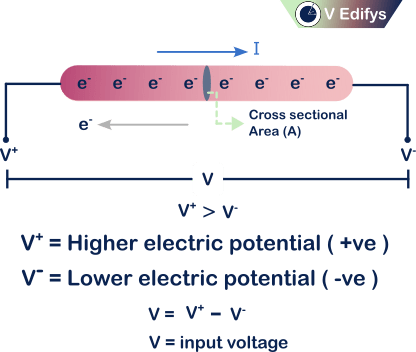
What is point charges?
A particle that holds some sort of electric charge ( i.e. positive charge (or) negative charge ) is called a point charge.
Ex :
- Sub-atomic particles like electrons and protons
- Ions ( whenever an atom loses (or) gains an electron )
- Positive ion = An atom losses an electron
- Negative ion = An atom gains an electron
- Holes = ( absence of an electron, think of it as a positive charge )
The physical significance of Electric voltage :
To understand Electric Voltage, first, we need to take a look at its importance in all our electric circuits. We all know, that whenever electric voltage is applied between an electrical element only then the current flows through it. But you may ask, why do we need voltage for the uniform flow of free electrons? (Uniform net movement of free electrons is known to be electric current).
Voltage – physical exploration :
Will voltage be the physical quantity? Does it exist in nature? or it’s just a fancy name to represent something else?
Voltage is not a physical quantity, it tells about how much the electric potential difference between the two points is. Voltage is just a fancy name to represent the electric potential differences.
These all are too confusing now, right? Let’s consider a simple real-world analogy, to understand the voltage. Let’s consider a water tap in a room of a house, and one water tank at the top of this house. Water pipes (e.g.: plastic PVC pipes ) connect the water tap to the water tank. The ultimate purpose of this setup is to provide water to the tap downstairs from the water tank, without manmade work. The water flow from top to bottom is possible only when there is a height difference between the water tank and the tap. If the water tank and tap are at the same height, then there will be no water flow.
Now, relate this analogy to our electrical system. The water tank will be considered an electric source. The tap is considered a load in the electrical system. The pipes that connect the tank and tap are considered an electrical connection (conducting materials) between the source and load. The flow of water inside the water pipe is considered the flow of electrons inside the conductor in the electrical system. Then the actual height difference between the tank and the tap is considered a potential difference in the electrical system. This potential difference is what we call voltage.
In the water pipe system, when there is no height difference between the water tank and the tap, there is no water flow in the pipe, in the electrical system when there is no potential difference (voltage) between the electrical elements, then there is no electron flow in the electrical system, in other words, there is no current flow in the electrical system.
Now, you may have a question, In the real world actually, gravity is pulling down the water from the tank, right? Yes, it’s kind of true, but gravity is not a force (it’s a complex topic to discuss here, so I save it for future discussion). Here simply just consider the combined effect of gravity, which is the reason for pulling down the water from the top tank to the bottom tap. Likewise, in the electrical system, the voltage is a combined effect of the electric field. Now you may ask me what is an electric field. I have an idea to explore electric fields in detail as a separate post, so I left it for a future discussion.
Gravity will be considered an electric field in the electrical system. In reality, gravity and electric field, are different but it is considered for our analogy both have a relationship between them.
What really happens inside the atom while applying an electric voltage across the material?
Basic Atomic structure :
To understand what happens inside the material at the atomic level, while applying voltage, first we need to know about basic atomic structure.
We know that every element in our universe is made up of atoms. Likewise, every atom contains subatomic particles like electrons, protons, neutrons etc.,
We all know that the nucleus is the center of every atom. The nucleus consists of sub-atomic particles like neutrons and protons. In every atom, there is an equal number of protons and electrons, that’s why the atoms are always electrically neutral. Neutrons are neutral, it doesn’t have any electrical charge particles which is why they are called neutrons.
- The electrons are negatively charged particles
- The protons are positively charged particles
In all the atoms, the nucleus is surrounded by the electron cloud. Let’s consider the “NIELS BOHR’s” atomic model, in which electrons circle the nucleus in distinct energy levels. The path in which the electrons are circled is known as an electron shell. The outermost electron shell (or) energy level is called the valence shell. Electrons in the valence shell are called valence electrons. These valence electrons tend to free themselves from the atom to act as free electrons. These free electrons aren’t influenced by any attractive force from their atomic nucleus anymore, so they move randomly inside the material.
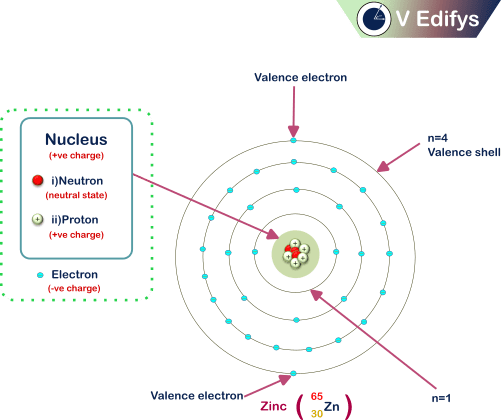
Here a zinc atom is given. It has 30 electrons and 30 protons, so its Atomic Number is 30. It has 35 neutrons, therefore its Mass Number is 65.
Atomic Number = Total number of electrons (or) Total number of protons
Mass Number = Arithmetic sum of Total number of electrons (or) protons + Total number of neutrons
How to decide how many electrons are present in an atomic shell?
There is a formula to decide, the number of electrons present in a shell.
Formula :
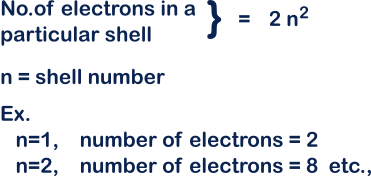
Here in our case, the zinc atom has a partially filled valence shell ( n=4 ). So, the electron in that valence shell tends to break its attractive bond with the atomic nucleus.
How an electron breaks its bond with the nucleus :
Electrons are attached to their nucleus with the attractive force between electrons and protons. Because the same electric charges repel each other and different electric charges attract each other. But electrons in the partially filled shells always try to break from this attractive bond, whenever possible. When electrons acquire the required energy to break this bond they will move freely inside the material. Electrons may get this energy, from surrounding temperature, by absorbing light energy (or) by some other chemical methods.

In conducting materials, at room temperature, the electron gains the required energy to break the bond and free itself. This is why conducting materials have a lot of free electrons at room temperature, this phenomenon makes the conducting materials superior for electrical conductivity.
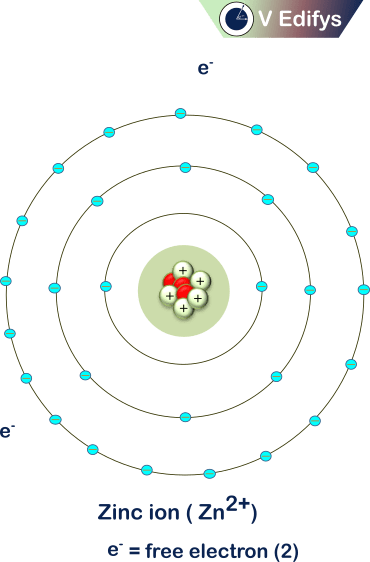
What is the significance of Electric Voltage for Electric Current :
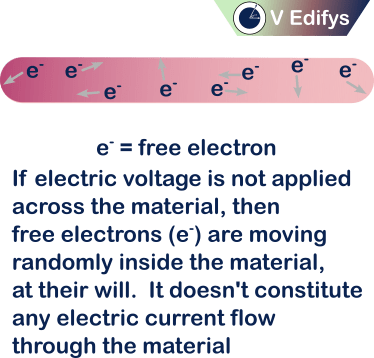
Now, you understand what is a free electron? and what causes the electron to become a free electron. In general, the uniform net movement of free electrons makes an electric current. The atoms, at room temperature, have a lot of free electrons, but these free electrons are moving randomly inside the material. So these free electrons’ net movement will cancel out each other. So this doesn’t constitute for Electric Current. If we change these free electrons’ random movement into a uniform movement in a particular direction, then that constitutes an electric current. How do we do this? The answer is simple, try to add potential differences between the two sides of the material, in fancy terms, add an Electric Voltage between the two sides of the material.
Voltage is the electric potential difference between the two ends of a material. So, one end of the material is in the higher electric potential ( let’s consider it as a positive potential ) and the other end of the material is at the lower electric potential ( let’s consider it as a negative potential ). Electrons are negatively charged particles, so they will be attracted by the positively charged particles because different charges attract each other. If we apply higher electric potential at the one end, it acts as a positive charge and attracts the electrons. Now, we make the electrons move uniformly in the same direction. This net movement will constitute an Electric Current.
It’s important to grasp the significance of electric voltage to grasp electric current. Without the Electric Voltage, we can’t force the electron to travel in a uniform direction, hence there will be no Electric Current possible.
Classification of Electric Voltage :
Electric Voltage is classified into two different types.
- Direct Voltage (DV)
- Alternating Voltage (AV)
1. Direct Voltage (DV)
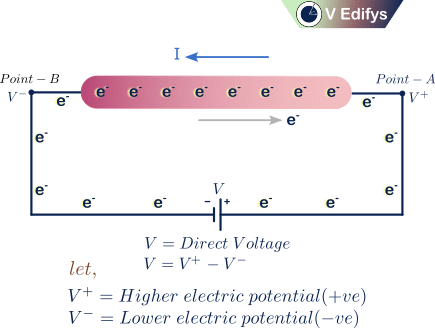
When an electric potential on the two ends of a material doesn’t change their places with time, then that kind of Electric potential difference is known as Direct Voltage. In Direct Voltage, the amplitude of the voltage either be constant (or) variable, but the electrical potential at each point, can’t change its polarity (i.e. higher (or) lower). What does it mean? If we give higher electric potential at point-A of the material and lower electric potential at point-B of the material, then their places can’t be changed throughout time. The vice-versa is also true. From our real-world analogy, if the tank is kept at the top, and the tap is kept at the room at the bottom, throughout the time the tank and tap can’t change their places. The distance between them can be varied, but their places can’t be switched.
Plotting Direct Voltage (DV) :
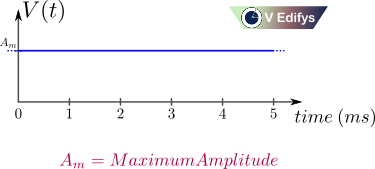
Here the amplitude of the electric voltage won’t change with time. Here the amplitude of electric voltage is constant throughout the time. What it indirectly tells us is that the electrical potentials at each point always be in the same place throughout time and don’t change their places.
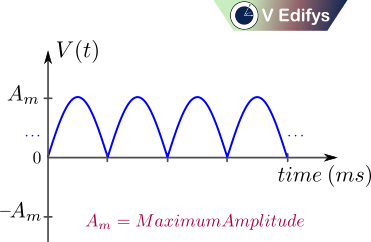
What do you think about this graph? Here the Electric Voltage changes its amplitude over time. Do you think it is an Alternating Voltage? No, this is not an Alternating Voltage, because the electric potentials still don’t change their places, they won’t change their places throughout time. From our real-world analogy, the height difference between the tank and the tap can be varied, but they don’t switch their places.
Here the Electric Voltage amplitude is varying, it doesn’t do anything with the electrons moving direction, because electrons are attracted by the higher electric potential, which is still in the same place in Direct Voltage the electric potentials don’t change their places. Still, if you are confused, then read the following sections.
2. Alternating Voltage (AV)

If electric potentials at both points of the material, switch their places once at a specific period of time, then the electric voltage (i.e. electric potential difference) is known to be Alternating Voltage (AV). The specific period of time is called the Fundamental Time Period. From our real-world analogy, the tank and the tap switch their places once at a specific period of time.
This process of switching the electric potentials place happens continuously, then this action constitutes a current called Alternating Current (AC). Why is that case? Electrons are attracted by the higher electric potential, if electric potential changes its places, it directly affects the electrons moving direction, then this action constitutes a current known as Alternating Current.
Let’s look at an example,
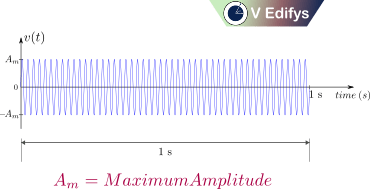
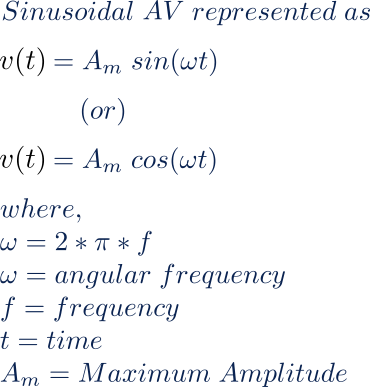
Most countries are using 50 Hz AV supply, In India, we are using 50 Hz AV which means the electric potentials are switched to their original places 50 times within a second. A few countries are using 60 Hz AV supply, In the US, Canada and some other parts of the world are using 60 Hz AV, which means the electric potentials are switched to their original places 60 times within a second.
Here, you may have a doubt, How to determine, how long the electric potential is at point-A of the material, before switching its place to point-B of the material? To answer this question first we need to understand some basics about Frequency (f) and Fundamental period (T).
Frequency (f) :
In simple words, “The Total number of cycles per second” is the simple definition of frequency. In plain English, frequency means how many times the same action happens over a particular period of time. What is meant by cycle here? How many times in AV the electric potentials are switching their original places at a specific period of time? What does it mean? let’s say if Electric Potential V+ is at point-A for a specific period of time, then it moves to the point-B for the same specific period of time. After that, this same process continued again. Here one cycle means the one complete switching of electric potential V+ between the point-A and point-B. Vice-versa is also true.
The S.I. Unit of the Frequency is “hertz” (Hz)
Fundamental Time Period (T):
The time taken to complete one cycle is called the Fundamental Time Period (T).
The S.I. Unit of the Fundamental Time Period is “seconds” (s).
There is a relationship between the Frequency (f) and Fundamental Time Period (T)
i.e.

In the case of 50 Hz AV,
T = 20 ms, which means the higher electric potential and the lower electric potential are kept at point-A and point-B respectively for the time duration between 0 ms to 10 ms. Similarly, in the time duration of 10 ms to 20 ms, the electric potentials switch their places, i.e. the higher electric potential and the lower electric potential are kept at point-B and point-A respectively.
Plotting of Alternating Voltage (AV) :

This looks too complex, right? Let’s do one thing, zoom the graph to look it closer. Here I only take one complete cycle of Electric Voltage.
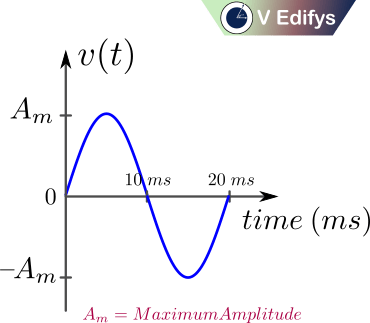
Here let’s consider the amplitude of Electric Voltage follows sinusoidal form. I am mathematically representing the AV in the sine format, i.e.  . Sine format is widely used to represent the AV.
. Sine format is widely used to represent the AV.
Here I take the Electric Voltage graph up to time period T=20 ms ( T=Fundamental Time Period). How I am saying this particular graph is an Alternating Voltage graph? Here the amplitude of the Electric Voltage varies over time and the electric potentials are changing their places between point-A and point-B continuously. I am denoting this phenomenon by plotting the graph above and below the X-axis respectively. In the case of DV, the amplitude of electric voltage changes with time, but it never crosses the X-axis which means the electric potentials are not switching their places.
case (i)

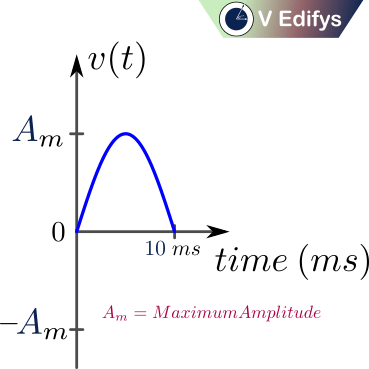
Here I am representing the amplitude of electric voltage as positive (+) in the time period of 0 ms to 10 ms. Am represents the maximum amplitude, during this time period the amplitude of the electric voltage varies with time. During this time interval, the AV is called positive half-cycle AV.
case (ii)
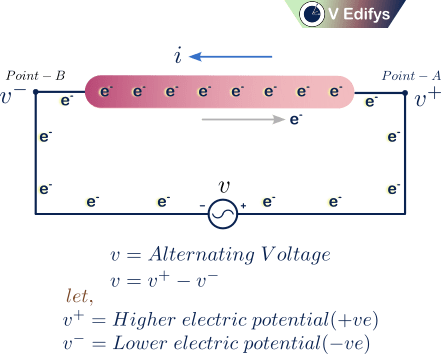

Here I am representing the amplitude of electric voltage as negative (-) in the time period of 10 ms to 20 ms. -Am represents the maximum amplitude, during this time period the amplitude of the electric voltage varies with time. During this time interval, the AV is called negative half-cycle AV. Have you ever wondered, how the electric voltage is negative (-)? Do you ever measure an electric voltage as -5 V? For me, the answer is, no. I may have some situation in the circuit analysis to represent the electric voltage as -5 V, but I never measured the electric voltage quantity as negative. What about you? In general, there is no negative (-5 V) electric voltage, but why do we use this notation to represent voltage?
A negative sign (-) doesn’t do anything, with the absolute value of the amplitude of the electric voltage. It is just a way to represent the position at which the electric potential is placed. Ex, When higher electric potential at point-A and lower electric potential at point-B, then the positive sign (+) is used to represent the amplitude of the electric potential difference (Voltage). When higher electric potential at point-B and lower electric potential at point-A, then the negative sign (-) is used to represent the amplitude of the electric potential difference (Voltage). The vice-versa is also true. The positive (+) and negative (-) signs don’t tell us the absolute value of the amplitude of the electric voltage. These are the tools to represent the electric potential position.
The following are also other examples of Alternating Voltage (AV)


Hereafter wherever you see an electric voltage amplitude graph with both positive (+) and negative (-) amplitudes then remember, that graph belongs to the Alternating Voltage (AV).
Summary :
- Now, you can understand electric voltage by its definition,
Proper textbook definition :
“The amount of work done in moving a unit point charge from one point to another.”
(or)
“Electrical potential difference between the two points is also known to be electric voltage.”
Electric Voltage is represented as “V” and its S.I. unit is “volt” (V).
Another S.I. unit of Electric Voltage is J/C (or) J C-1.
We have already seen that electric voltage is the, “Work done per unit charge”. Work done (W) is also known to be Potential Energy (U). It is mathematically represented as

Note :
- Electric potential is taken at a point.
- Electric voltage is considered between two points.
- There are two types of Voltage.
- Direct Voltage (DV)
- Alternating Voltage (AV)
3. The negative sign in the electric voltage amplitude doesn’t tell us, its absolute value. It deals with the electric potential places at a point.

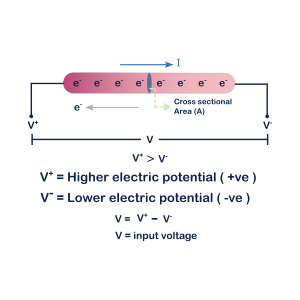

3 Responses
Very interesting topic, appreciate it for putting up.
Thanks for sharing your thoughts on odessa forum.
Thanks for sharing your thoughts on odessa forum.